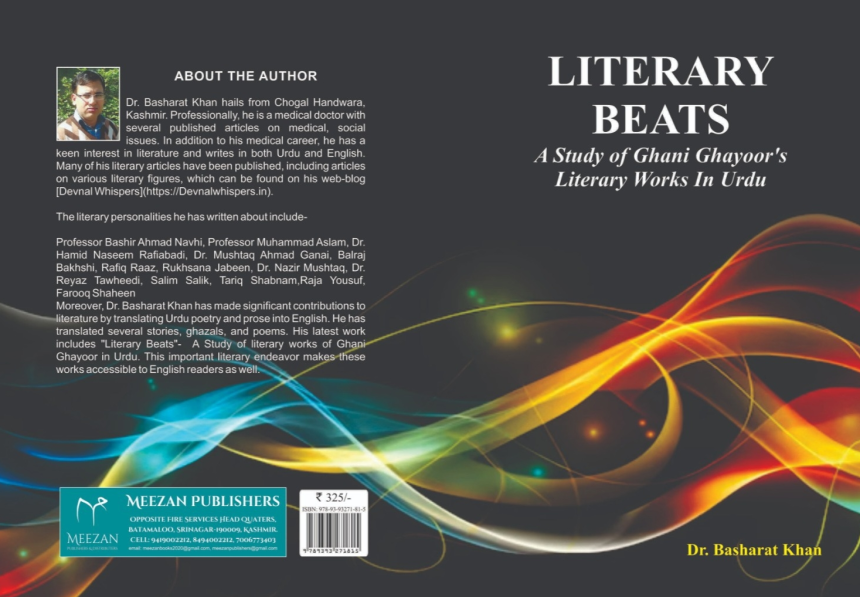BOOK REVIEW
The book actually encapsulates the literary endeavour of Ghani Ghayoor in a lucid style. Besides the glimpses of Ghayoor’s own literary output, the author has highlighted his work on Baidil and Sa‘di through Muhit-i Bai-Sahil and Sa‘di: Sukhan wa Qalam. Ghayoor’s Naqsh-i Daigar is the biography of Dr. Masood Ahmad Choudhary, the former VC of BGSBU Rajouri. The author is of the view that the verses of Dair Tak have some semblance with the wisdom of Sa‘di while as Sukhan Qalam Qalam, the author says, is the “tangible proof of his literary prowess.”
One of the interesting things noticed by and deliberated upon by the author is the “bird motif” in Ghayoor’s poetry. Bird, we know, not only eschews materialistic accumulation but also loves and yearns for freedom. Nevertheless, birds become the first casualty of the human hunters:
chali thi goliyan logun pe laikin
parinday muft main ghayal huy’ai hain
Nevertheless, Ghayoor’s poetry, according to the author, “embodies a dynamic spirit– migratory symbol that represents both altruism and adventure.” It is very interesting to note here that according to Dr. Ali Shari‘ati, Iranian sociologist and student of Jean-Paul Sartre, almost all the major world civilizations are an outcome of migration when people, in the Ghayoorian words, moved to search for “ab-o dana” and in this search they got “udanun ka bahana”.
Azar-i Jan, deriving its title from,
aaftabun ka budhapa, baraf zarun ki khushi
sabaz patun kay liyai azar-i jan likha gaya,
is an anthology with Muqaddima of 100 ghazals of Hakim Manzoor. Likewise, Nakhl-i Nur presents an anthology with Muqaddima of 100 ghazals of Rafiq Raaz. Ma‘qulat-i Ghani Ghayoor is a collection of the poetry of some famous Gojri poets.
As the title of the book suggests, a “beat of music” synchronizes with the “beat of heart” which continues the symphony of life on earth. We know, no one else can know the “heart beat” more than a lover does! And, in the realm of love, medical doctors, more often than not, are the lovers of whole humanity.
A medical doctor by profession and a litterateur by passion, Dr. Basharat Khan, through the Literary Beats, has tried to become a testimony to the literary tryst of Ghani Ghayoor. The book could be counted as the author’s “heart beat” as, according to the author himself, his heart has “always beaten for literature.”
The book provides a bird’s-eye-view of Ghani Ghayoor’s rendezvous with literature in 12 brief chapters besides References and Photo Album. The very Introduction begins with the beautiful couplet:
khayal-i khas jo andar hi andar pakgta rahta hai
Ghani izhar ki qudrat hunar hai, aur hunar kiya hai
That is, the journey which the Homo Sapiens (Latin, Homo–human/man & Sapiens–astute/wise) have been going through unfolds itself in “consciousness” and “knowledge” which cannot be externalized unless a due process of internalization takes place. This process turns an immature thought into a mature one. So, the “stuff” needs a “style” to be known externally.
Now, human beings don’t constitute of “thought” alone. Rather, the “thought” is coupled with “will.” This “will,” however, has been subjected to persecution and coercion throughout the ages. Ghayoor, in this regard, says:
ankhun par pahray bithata hai mairi
wahi tangun ko bhi phir bandhta hai
Nevertheless, the hardships thereof help us to gain self actualization:
kashmakash hi zindagi hai asal main
mushkilun main rahnay wala zinda hai
As per Ghalib:
in abilun sai pawun kay ghabra gaya tha main
ji khush huwa rah ko pur khar daikh kar
Ghayoor has also expressed the universal idea of “to strain at a gnat and swallow the camel” (Matthew, 23:24) as: makhi ko yar chhod kay hathi nigal gayai.
No doubt one’s tormentors can take sadistic pleasure from the pain and agony of their victims, but the victims on their part get catharsis because they relate the suffering with the perennial pain which has been the lot of humanity:
kis nay gunthi thi darad ki rasi
raishay raishay main tanaw jaisa tha
As per Rumi:
sinah khawaham sharha sharha az firaq
ta bigoyam sharh-i darad-i ishtiyaq
Ghayoor also touches the Absurdist tone when he says:
chiyuntiyun kay bil main pani dal kar
kiyun tamasha daikhta hun dair tak
If human beings partake in the Reality, how can they know the Reality holistically? Ghayoor says:
idrak nahin in ko haqiqat nahin ma‘lum
woh zujwi samandar hain samandar main paday hain
So, oblivious of the Reality as such, what remains behind is nothing but “folly” and “vain desire.” According to Ghayoor:
adhuri khawahishain, jannat kay da‘way
paraishan log kitnay khush guman hain
However, the sublime status, such as the Paradise could be thought of by a person whose heart is overflowing with the milk of sincerity, devotion and love. To this effect, Ghayoor says:
‘ishq tairay nay ujada dil maira
ghair ki ulfat ugay mumkin nahin
The perpetual endeavour and seamless effort for the achievement of a sublime motive is the theme of many a couplet of Ghayoor:
admi ko juhdi paiham kay liyai paida kiya
pait bhar kar tou nahin kam bakhat marnay kai liyai
However, sometimes the contemplation of the Being on the part of the individual (being) puts the whole activity on rest and the poet says:
is ka hona hai har aik sha’y ki dalil
do jahan ki wahi asas badan
Isn’t it similar to the Tad Ekam; that is, That One, That Being, Spiritual Embryo or Consciousness of the Rig Ved?
It takes us towards yet another dimension of the Being as the product or outcome of this contemplation, as our poet says:
wus‘atun ki nahin hai us ki had
bai tahasha woh bai qayas badan
Can’t we invoke here the subhani am a‘zama shani utterance of Abu Yazid Bastami?
Ghayoor also gives a combined view of Monotheism and Monism when he says:
dusra koy’i nahin jab
kiyun saharay dhundta hai
Ghayoor also talks about the “collective conscience” of his native people by saying:
khayai ga hisa dusray ka bhi
khud gharaz woh qatar badlay ga
We know, this “line changing attitude of ours” is not rampant only when we “receive kerosene (the practice is now obsolete), sugar or rice,” we also exhibit it day in and day out while changing “caravans!”
The author, as such, has elegantly portrayed the literary output of Ghani Ghayoor. Although the translation is up to the mark, but any standard transliteration format has not been followed. Also, the biographical sketch of our poet has not been presented in an ordinate manner. Although the get-up of the book is up to the mark, but Meezan Publishers should have “maintained the balance (Meezan)” while publishing the book more seriously! Nevertheless, the book is still a bouquet, an arranged bunch of literary flowers, an everlasting gift for the lovers of literature which has the capacity to make their hearts throb and beat; thus the Literary Beats!
(The author is Assistant Professor, Islamic Studies at GDC Sogam. Feedback: [email protected])










